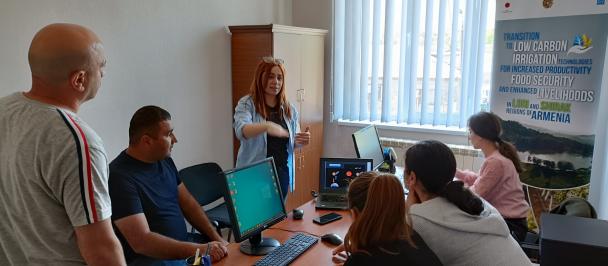
Teiba Mamu, second from right, with UNDP colleagues and Mr. Ian Rakafia, Project Coordinator of the St. Luke Faea Water Project.
Reflections by Teiba Mamu, SGP Project Manager
Tikopia Island, Temotu Province - After several years working with the Small Grants Programme (SGP), funded by the Global Environment Facility (GEF) and administered by UNDP, I thought I had a good sense of what “remote” meant in the Solomon Islands. I’ve been to the Reef Islands in Temotu Province, and coming from a community in Western Province myself, I know what it’s like to live far from Honiara or any major urban center. But nothing prepared me for Tikopia.
Tikopia isn’t just remote. It’s another world.
Tucked away in the southeastern corner of Solomon Islands, this tiny volcanic island—just five square kilometers—is a green jewel surrounded by endless blue. Home to around 1,200 people of Polynesian descent, Tikopia is steeped in tradition, culture, and community governance that has withstood the tests of time and climate.
When I first heard about the St Luke Community Faea Water Project, I was excited. After more than 20 years of hardship, five communities—four in the Faea District and one in Ravenga—were finally regaining access to clean, sustainable water through a network of dams and 31 standpipes. That’s 576 people now drinking, cooking, and washing with clean water, right at their doorsteps. It is a milestone achievement—and I had been eager to witness it. But getting there was no easy feat.
The Journey: Crossing into the Unknown
The most common way to reach Tikopia is by ship. However, our team took the less common—and riskier—route: by boat. As we left Lata, the provincial capital of Temotu, the feeling was unlike any of my previous trips within Solomon Islands. It felt as though we were traveling beyond the edge of the known world, crossing vast stretches of ocean armed with a compass, offline GPS maps, and a lot of trust in the sea.
Hours passed, and the ocean seemed endless. Even with my experience traveling across the provinces, this journey stood apart. It reminded me how truly isolated some parts of our country are, and how service delivery—something we often take for granted in urban centers—is a challenge many communities live without for years, even decades.
Tradition First: A Visit to the Chiefs
Upon arrival, our first obligation was to observe traditional protocol. Tikopia is governed by four chiefs, and visiting each of them is not just a matter of respect—it’s a vital part of community connection.
What struck me most was entering a chief’s thatched hut, designed with a tiny doorway that requires you to crawl on your knees. It’s humbling, purposeful, and symbolic—a physical reminder of the humility required in the presence of leadership. These structures are not merely ceremonial. Designed to withstand fierce cyclones, they reflect traditional knowledge and climate resilience—long before the term “climate adaptation” entered our vocabulary.

Teiba Mamu, SGP Project Manager drinking from one of the new project’s tap in Tikopia.
Water Is Life—And Now, It’s Within Reach
The highlight of my visit was seeing the impact of the St Luke Community Faea Water Project firsthand. For years, families had relied on rainwater tanks and a decaying 1980s-era water system that had dwindled to a single, usually dry standpipe. During droughts, mothers and children walked long distances, sometimes for hours, to fetch water.
Now, with two newly constructed dams and a network of standpipes across the five villages, water is at their fingertips.
I spoke with Mr. Pae Seivaea, Chairman of the St Luke Community, who told me, “This project has relieved one of our longest-standing burdens.” The joy and pride on his face said it all. For the first time in decades, the community no longer has to choose between collecting water or tending to their gardens.
Masi and the Spirit of Resilience
Water is not the only challenge. Tikopia’s resilience is also embedded in its food systems. One example is the traditional preservation of masi, a fermented cassava pudding stored in underground pits. This staple becomes a lifeline when food gardens are destroyed by cyclones or droughts.
This method is not just cultural—it is survival. In a place so isolated, where the next shipment may not arrive for weeks or months, these practices ensure families have something to eat during lean times. It reflects generations of wisdom, planning, and resilience.
Reflecting on Resilience and Community
As I reflect on this journey, I am filled with admiration for the people of Tikopia. Their resilience is evident in every part of their lives. They have faced cyclones, droughts, and the limitations of isolation—and have adapted with grace and ingenuity.
The Tikopia people embody resilience. They have endured hardships many of us can hardly imagine, and they continue to thrive—not through reliance on external aid, but through unity, tradition, and a deep connection to their environment. Their strength is an inspiration.
A Hope for Connection
As I bid farewell to Tikopia, I carry with me a hope—for better connectivity, without compromising tradition. While Tikopia’s isolation has preserved its unique culture, improved access to shipping and communications would help the community navigate future challenges more easily.
This project has shown what’s possible when communities lead and development partners listen and support. The people of Tikopia earned every drop of that clean water through their patience and resilience. It was the first time the Small Grants Programme supported an initiative in Tikopia—but I hope it won’t be the last.
Because in Tikopia’s quiet strength, I saw not just resilience—I saw hope.
For more information or media inquiries please contact:
Daniel Gonzalez, Communications Specialist, UNDP Solomon Islands Office, daniel.calderon.gonzalez@undp.org

 Locations
Locations


